
The Palace of Westminster is the meeting place of the Parliament of the United Kingdom and is located in London, England. It is commonly called the Houses of Parliament after the House of Commons and the House of Lords, the two legislative chambers which occupy the building. The palace is one of the centres of political life in the United Kingdom; "Westminster" has become a metonym for the UK Parliament and the British Government, and the Westminster system of government commemorates the name of the palace. The Elizabeth Tower of the palace, nicknamed Big Ben, is a landmark of London and the United Kingdom in general. The palace has been a Grade I listed building since 1970 and part of a UNESCO World Heritage Site since 1987.
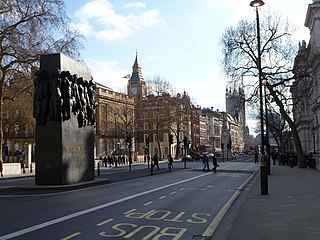
Whitehall is a road and area in the City of Westminster, Central London, England. The road forms the first part of the A3212 road from Trafalgar Square to Chelsea. It is the main thoroughfare running south from Trafalgar Square towards Parliament Square. The street is recognised as the centre of the Government of the United Kingdom and is lined with numerous departments and ministries, including the Ministry of Defence, Horse Guards and the Cabinet Office. Consequently, the name "Whitehall" is used as a metonym for the British civil service and government, and as the geographic name for the surrounding area.
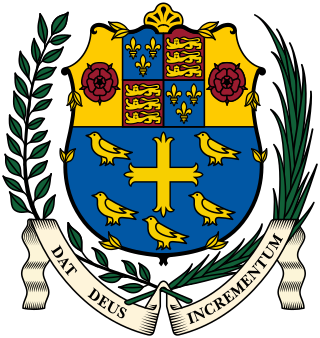
Westminster School is a public school in Westminster, London, England, in the precincts of Westminster Abbey. It descends from a charity school founded by Westminster Benedictines before the Norman Conquest, as documented by the Croyland Chronicle and a charter of King Offa. Continuous existence is clear from the early 14th century. Westminster was one of nine schools examined by the 1861 Clarendon Commission and reformed by the Public Schools Act 1868. The school motto, Dat Deus Incrementum, quotes 1 Corinthians 3:6: "I planted the seed... but God made it grow."

The Palace of Westminster, the medieval royal palace used as the home of the British parliament, was largely destroyed by fire on 16 October 1834. The blaze was caused by the burning of small wooden tally sticks which had been used as part of the accounting procedures of the Exchequer until 1826. The sticks were disposed of carelessly in the two furnaces under the House of Lords, which caused a chimney fire in the two flues that ran under the floor of the Lords' chamber and up through the walls.

The Marble Arch is a 19th-century white marble-faced triumphal arch in London, England. The structure was designed by John Nash in 1827 as the state entrance to the cour d'honneur of Buckingham Palace; it stood near the site of what is today the three-bayed, central projection of the palace containing the well-known balcony. In 1851, on the initiative of architect and urban planner Decimus Burton, a one-time pupil of John Nash, the arch was relocated to its current site, near the northeast corner of Hyde Park, so that expansion of Buckingham Palace could proceed.

Parliament Square is a square at the northwest end of the Palace of Westminster in the City of Westminster in central London, England. Laid out in the 19th century, it features a large open green area in the centre with trees to its west, and it contains twelve statues of statesmen and other notable individuals.
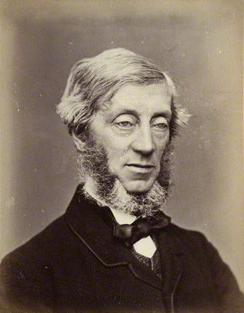
William Reginald Courtenay, 11th Earl of Devon PC, styled Lord Courtenay between 1835 and 1859, was a British politician who served as Chancellor of the Duchy of Lancaster from 1866 to 1867 and as President of the Poor Law Board from 1867 to 1868.

Old Palace Yard is a paved open space in the City of Westminster in Central London, England. It lies between the Palace of Westminster to its north and east and Westminster Abbey to its west. It is known as the site of executions, including those of Sir Walter Raleigh, Guy Fawkes and other conspirators of the Gunpowder Plot, and James Hamilton, 1st Duke of Hamilton, following the Battle of Preston.

The equestrian statue of Charles I at Charing Cross, London, England, is a work by the French sculptor Hubert Le Sueur, probably cast in 1633 during Charles’ lifetime. It is the oldest bronze statue in London and is considered the central point of the city.

Richard Coeur de Lion is a Grade II listed equestrian statue of the 12th-century English monarch Richard I, also known as Richard the Lionheart, who reigned from 1189 to 1199. It stands on a granite pedestal in Old Palace Yard outside the Palace of Westminster in London, facing south towards the entrance to the House of Lords. It was created by Baron Carlo Marochetti, an Italian sculptor whose works were popular with European royalty and the nobility, though often less well regarded by critics and the artistic establishment. The statue was first produced in clay and displayed at The Great Exhibition in 1851, where it was located outside the west entrance to the Crystal Palace. It was well received at the time and two years later Queen Victoria and Prince Albert headed a list of illustrious subscribers to a fund that aimed to raise money for the casting of the statue in bronze.
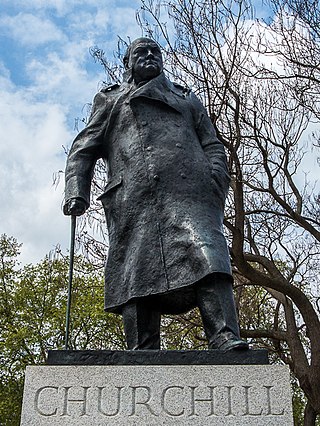
The statue of Winston Churchill in Parliament Square, London, is a bronze sculpture of the former British prime minister Winston Churchill, created by Ivor Roberts-Jones.
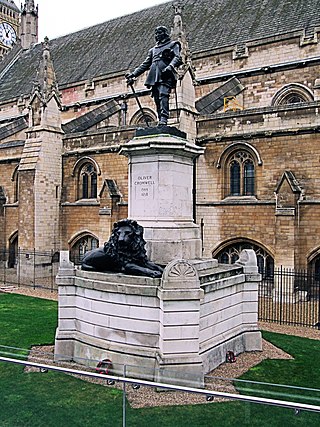
A statue of Oliver Cromwell stands outside the House of Commons of the United Kingdom in Westminster, London. Oliver Cromwell was Lord Protector of the Commonwealth of England, Scotland and Ireland between 1653 and 1658. Directly opposite the statue, in the wall of St Margaret's Church, on the other side of the road, is a bust of Charles I.

The statue of George IV in Trafalgar Square, London, is a bronze equestrian statue by Sir Francis Legatt Chantrey. It depicts the King dressed in ancient Roman attire and riding bareback. The sculpture was originally designed to sit on top of the Marble Arch at the entrance to Buckingham Palace, but was placed in its current location following the King's death.

The Parliamentary War Memorial, also known as the Recording Angel Memorial, is a stone sculpture in Westminster Hall, unveiled in 1922, which commemorates the members of both Houses of Parliament of the United Kingdom who died in the First World War. It names 22 members of the House of Commons, 20 members of the House of Lords, and 9 senior members of staff, together with another 94 sons of members and officers of the House of Commons, who lost their lives in the war. Above the memorial is a large stained glass window which commemorates members and staff of both Houses who died in the Second World War.

Boadicea and Her Daughters is a bronze sculptural group in London representing Boudica, queen of the Celtic Iceni tribe, who led an uprising in Roman Britain. It is located to the north side of the western end of Westminster Bridge, near Portcullis House and Westminster Pier, facing Big Ben and the Palace of Westminster across the road. It is considered the magnum opus of its sculptor, the English artist and engineer Thomas Thornycroft. Thornycroft worked on it from 1856 until shortly before his death in 1885, sometimes assisted by his son William Hamo Thornycroft, but it was not erected in its current position until 1902.

A bronze statue of Admiral of the Fleet Louis Mountbatten, 1st Earl Mountbatten of Burma is located on Mountbatten Green, off Horse Guards Road, Whitehall, London, England. The sculptor was Franta Belsky and the work was cast by the Meridian Bronze Foundry. The memorial was unveiled on 2 November 1983.

The Emmeline and Christabel Pankhurst Memorial is a memorial in London to Emmeline Pankhurst and her daughter Christabel, two of the foremost British suffragettes. It stands at the entrance to Victoria Tower Gardens, south of Victoria Tower at the southwest corner of the Palace of Westminster. Its main feature is a bronze statue of Emmeline Pankhurst by Arthur George Walker, unveiled in 1930. In 1958 the statue was relocated to its current site and the bronze reliefs commemorating Christabel Pankhurst were added.

The equestrian statue of Prince George, Duke of Cambridge is a life-size memorial by Adrian Jones, installed in Whitehall, London, England.

The statue of George Canning in Parliament Square, Westminster, London, is an 1832 work by Sir Richard Westmacott.




















